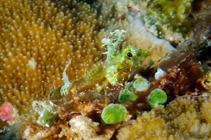| Family: |
Tripterygiidae (Triplefin blennies), subfamily: Tripterygiinae |
| Max. size: |
2.7 cm SL (male/unsexed) |
| Environment: |
reef-associated; marine; depth range 8 - 37 m |
| Distribution: |
Southwest Pacific: northern Australia and Papua New Guinea. |
| Diagnosis: |
Dorsal spines (total): 13-16; Dorsal soft rays (total): 8-11; Anal spines: 1-1; Anal soft rays: 16-20. Description: Semitransparent greenish with white saddle below near part of second and third dorsal fin, or whitish with 4-5 greenish to brownish bars (sometimes branched ventrally); first dorsal fin and margins of second and third dorsal fin whitish. Dorsal rays III + X-XIII + 8-11; anal rays I,16-20; pectoral rays 13-14; pelvic rays I,2; lateral line interrupted, 5-12 + 20-29; head, chest, and pectoral-fin base scaleless; short orbital tentacle present; mandibular pores 4 + 2 + 4; first dorsal fin very tall, much higher than second dorsal, sometimes with filamentous tip on first spine. Maximum size 3.3 cm TL (Ref. 90102). |
| Biology: |
Adults are found in coral reef areas, on reef slopes close to the outer reef (Ref. 13227). Eggs are hemispherical and covered with numerous sticky threads that anchor them in the algae on the nesting sites (Ref. 240). Larvae are planktonic which occur primarily in shallow, nearshore waters (Ref. 94114). |
| IUCN Red List Status: |
Least Concern (LC); Date assessed: 03 May 2010 Ref. (130435)
|
| Threat to humans: |
harmless |
| Country info: |
|
Source and more info: www.fishbase.org. For personal, classroom, and other internal use only. Not for publication.

